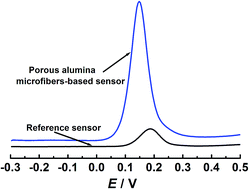Electrode modified with porous alumina microfibers as a highly sensitive electrochemical sensor for quercetin
Abstract
Porous alumina microfibers were prepared via a hydrothermal reaction using Al(NO3) and urea as the precursors. The resulting alumina microfibers were used to modify a carbon paste electrode and to construct a new electrochemical sensor for quercetin. The modified alumina microfibers greatly increased the oxidation signals of quercetin, showing strong signal enhancement effects. The influence of pH, the amount of alumina microfibers, the accumulation potential and the accumulation time on the oxidation peak currents of quercetin were examined. A highly sensitive, rapid and reliable electrochemical method was developed for the determination of quercetin. The linear range was from 25 nM to 1.5 μM and the detection limit was 10 nM (3.02 μg L−1) after 1 min of accumulation time. The proposed method was used to determine quercetin in different samples of tea and honeysuckle and the obtained results were in good agreement with those obtained by high-performance liquid chromatography.


 Please wait while we load your content...
Please wait while we load your content...